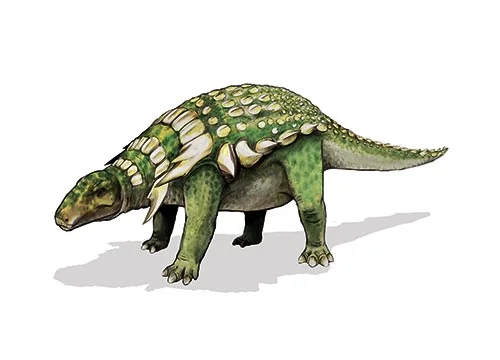Panoplosaurus (Completely armoured lizard)

Pan-op-lo-sore-us
Lawrence M. Lambe - 1919
Herbivore
Estimated 8 meters long
Armoured Dinosaur
P. mirus (type)
Canada, Alberta - Dinosaur Park Formation, Saskatchewan - Judith River Formation. USA, Montana - Bearpaw Shale Formation, New Mexico - Ojo Alamo Formation
Late Cretaceous, 76-66 million years ago
Panoplosaurus Facts
Panoplosaurus, meaning “completely armoured lizard” in Greek, was a genus of herbivorous ankylosaurid dinosaur that lived in North America during the Late Cretaceous period, approximately 76-66 million years ago.
Panoplosaurus had a heavily armoured body, with bony plates covering its back, sides, and even its eyelids. It had a club-like tail that it used for defense against predators, as well as a sharp beak and rows of teeth that it used to chew tough plant material. It was a large dinosaur, reaching lengths of up to 8 meters (26 feet) and weighing over 4,500 kg (10,000 pounds).
Like other ankylosaurids, Panoplosaurus had a low-slung body and four sturdy legs, with hoof-like toes. Its tail was made up of a series of bony segments that gradually became larger towards the end, which was capped with a large knob-like structure. This knob would have been a formidable weapon against predators, such as tyrannosaurs, that tried to attack Panoplosaurus.
Panoplosaurus is known from several well-preserved fossils found in Canada and the United States. These fossils have provided valuable information about the anatomy and lifestyle of this unique dinosaur. One notable fossil, found in Alberta, Canada, even included preserved skin impressions, which have allowed scientists to better understand the texture and pattern of the dinosaur’s armor.
In conclusion, Panoplosaurus was a heavily armoured herbivorous dinosaur that lived in North America during the Late Cretaceous period. Its bony plates, club-like tail, and sharp beak and teeth made it a formidable herbivore, while its armored eyelids protected its eyes from potential predators. Fossils of Panoplosaurus have provided valuable insights into the biology and behavior of this fascinating dinosaur.



